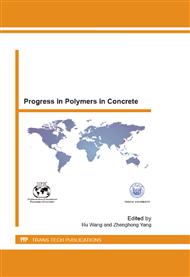[1]
Y. Ohama, Principle of Latex Modification and Some Typical Properties of Latex-modified Mortars and Concretes, ACI Materials Journal. (84) 1987 511-518.
DOI: 10.14359/2463
Google Scholar
[2]
M. U. K. Afridi, Y. Ohama, M. Zafar Iqbal, K. Demura, Water Retention and Adhesion of Powdered and Aqueous Polymer-Modified Mortars, Cement and Concrete Composites. (17) 1995 113-118.
DOI: 10.1016/0958-9465(95)00007-y
Google Scholar
[3]
Yoshihiko Ohama, Polymer-based Admixtures, Cement and Concrete Composites. (20) 1998 189-212.
DOI: 10.1016/s0958-9465(97)00065-6
Google Scholar
[4]
Liang Nai-xin, Polymer Modified Cement Concrete, Beijing, China Communications Press, 1995. (in Chinese)
Google Scholar
[5]
Zhong Shi-yun, Yuan Hua, Application of Polymer in Concrete, Beijing, Chemical Industry Press, 2003. (in Chinese)
Google Scholar
[6]
BUREAUL, ALLICHEA, PILVIN P, et al, Mechanical Characterization of a Styrene-butadiene Modified Mortar, Materials Science and Engineering(A). (308) 2001 233-240
DOI: 10.1016/s0921-5093(00)01980-8
Google Scholar
[7]
Li Jian, Wang Pei-ming, Wang Ru, Mechanical Properties and Bulk Density of Styrene-butadiene Copolymer Emulsion(SD622S) Modified Cement Mortar, Journal of Building Materials. 8 (2005) 705-709. (in Chinese)
Google Scholar
[8]
Wang Ru, Wang Pei-ming, Application of Polyacrylic Ester Latex to Cement Mortar, Journal of the Chinese Ceramic Society. 36 (2008) 946-949. (in Chinese)
Google Scholar
[9]
Zhong Shi-yun, Ma Ying, Mechanical Properties of Polymer-Modified Self-levelling Mortars, Journal of Building Materials. 8 (2005) 77-81. (in Chinese)
Google Scholar
[10]
Wang Pei-ming, Xu Qi, J.Stark, Mechanical Properties of Styrene-butadiene Emulsion Modified Cement Mortar Used for Repair of Bridge Surface, Journal of Building Materials. 4 (2001) 1-6. (in Chinese)
Google Scholar
[11]
Wang Ru, Wang Pei-ming. Influence of Styrene-butadiene latex emulsion and powder on the early process of cement hydration. The Proceedings of the Second National Academic Conference of Commercial Mortars. 11 (2007) 73-80.
Google Scholar
[12]
Xu Feng, Liu Lin-jun, Polymer cement-based building materials and applications, Beijing, China Building Industry Press, (2010).
Google Scholar


